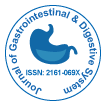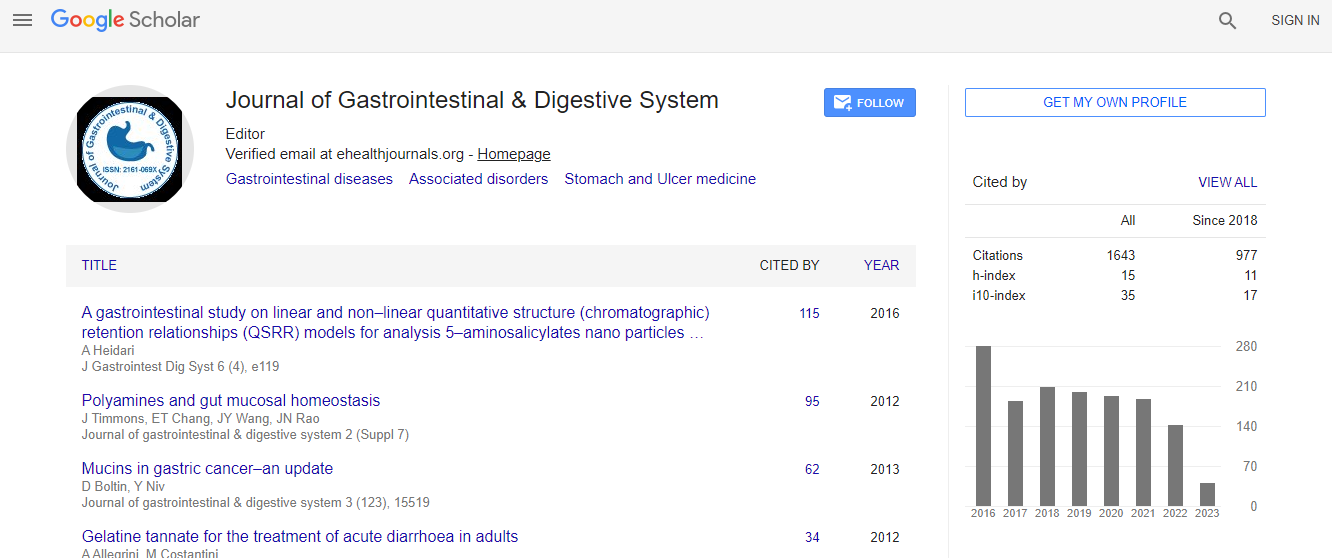Our Group organises 3000+ Global Conferenceseries Events every year across USA, Europe & Asia with support from 1000 more scientific Societies and Publishes 700+ Open Access Journals which contains over 50000 eminent personalities, reputed scientists as editorial board members.
Open Access Journals gaining more Readers and Citations
700 Journals and 15,000,000 Readers Each Journal is getting 25,000+ Readers
Google Scholar citation report
Citations : 2091
Journal of Gastrointestinal & Digestive System received 2091 citations as per Google Scholar report
Journal of Gastrointestinal & Digestive System peer review process verified at publons
Indexed In
- Index Copernicus
- Google Scholar
- Sherpa Romeo
- Open J Gate
- Genamics JournalSeek
- China National Knowledge Infrastructure (CNKI)
- Electronic Journals Library
- RefSeek
- Hamdard University
- EBSCO A-Z
- OCLC- WorldCat
- SWB online catalog
- Virtual Library of Biology (vifabio)
- Publons
- Geneva Foundation for Medical Education and Research
- Euro Pub
- ICMJE
Useful Links
Recommended Journals
Related Subjects
Share This Page
View of the non-alcoholic fatty liver in non-obese patients from mafld perspective
13th International Conference on Liver Diseases & Hepatology
Michel Gonzalez Sanchez
University of Valencia, Cuba
ScientificTracks Abstracts: J Gastrointest Dig Syst
Abstract
A novel concept consensus by an international panel of experts recommended a change in name for NAFLD to metabolic (dysfunction) associated fatty liver disease (MAFLD). The new definition is a landmark in hepatology bringing a new way of thinking about diseases of the liver that are associated with fat deposition and metabolic dysfunction Importantly, this ├ó┬?┬?MAFLD definition├ó┬?┬Ł avoid the dichotomous view of NAFL and NASH, since it is based in ├ó┬?┬?positive├ó┬?┬Ł criterion (evidence of hepatic steatosis) instead of ├ó┬?┬?negative├ó┬?┬Ł criterion hard to exclude. Lean NAFLD is defined as hepatic steatosis with a BMI <25 kg/m2 in non-Asian people or BMI <23 kg/m2 in Asians. Main Text: At present, it is not possible to define a phenotype of Metabolic Healthy Obesity (MHO) due to the lack of consensus. This disparity is due to the difference in defining metabolic health found by some authors when studying the phenotypes of subjects with unhealthy metabolic weight. We generally associate the development of NAFLD Patients with Obesity, but in opposition to this, READ patients can also develop this disease, especially when we find visceral obesity associated with a strong genetic predisposition and an altered and unhealthy diet pattern. Here is the importance of addressing important concepts such as metabolic unhealthy normal weight, MUHO, MHO, as well as the interrelationship that all of them have with the distribution of body fat. For this reason, for the sake of understanding and finding a clinical-pathophysiological relationship of the disease, I try to follow a route which helps me to better understand said relationship of importance in the study of Metabolic Association of Fatty Liver. It is essential to start from the term MAFLD which follows 2 routes, one in obese patients and the other in non-obese patients. Conclusion: Adequate understanding of the spectrum of MAFLD in association with non-obese NAFLD constitutes a new line of research which would provide a better and more exhaustive understanding of the relationship between metabolic dysfunction and fatty liver disease, especially in non-obese patients in any of It would be necessary to delve further in non-Asian patients to establish a better characterization of the disease. In another order, it is very important to establish clinical criteria in correlation with the pathophysiological pathways of the disease. This will allow a greater approach and management of the patient with this type of condition, giving us benefits beyond the simple understanding that until now we have had about the fatty liver.Biography
1st Degree specialist in Family Medicine, Master in Bioethics from the ¨San Vicente Martir ´´ University of Valencia. Diploma in Internal Medicine. Member of the Global Liver Institute and the American Liver Foundation. Member of United European Gastroenterology, Board Member of Acta Scientific International Open Library and International member of Chang Gung Medical Education Research. Am Lecturer of Medical University of Villa Clara.

 Spanish
Spanish  Chinese
Chinese  Russian
Russian  German
German  French
French  Japanese
Japanese  Portuguese
Portuguese  Hindi
Hindi 
